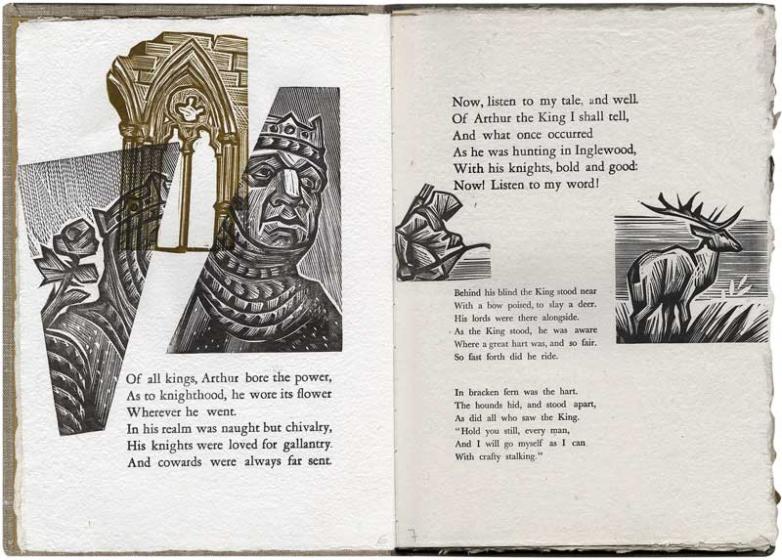With an aesthetic style all his own, Sayenko makes the books by hand, cutting the linoleum blocks for the illustrations, binding the books, setting the type, and printing the books himself. In recent years, he also began hand making the paper specifically matched to each project.
Sayenko’s most recent book, The Wedding of Sir Gawain, was released this October and tells a little-known tale from Arthurian legend. The book was conceived by author James J. Owens, who approached Sayenko about the project. The text comes from Owens’s modern English translation of Frederick Madden’s 1839 transcription of the tale. “This is very much the author’s project,” Sayenko said. “I saw my part of it to illuminate the text in a way that would bring the period of the Medieval Age to life.”
This book is the first time the text has been rendered in contemporary English. “Arthurian legends are timeless and are brought to life here by the illustrations; coupled with the absolute contemporary moral of this story,” Sayenko said. “In it, Gawain falls in love with his bride when he allows her to make her own decisions. Gawain sacrifices his own desires and, by so doing, delivers Dame Ragnell from a spell she had been under.”
The Wedding of Sir Gawain, published by Sayenko this year, is comprised of two volumes issued in an edition of 20 numbered and signed copies. The main volume contains more than 50 color linocuts by Sayenko. The illustrations were printed directly from Sayenko’s blocks, and the paper and binding were also handmade by the artist.
Sayenko’s vision for the book was to present it as a “found” book. He created an introduction in which the new owner of an old house found scattered pages of the book. The story is then presented in fragments as if they were the found pages. Thematically, the illustrations center on old medieval buildings or churches with dilapidated architecture.
“In preparation for this work I travelled to Northern Normandy, Southern England, and Scotland,” Sayenko said. “In viewing the remains of medieval architecture and artifacts, I noticed that the artists of that time used an exaggerated, grotesque style, with heads that were abnormally large, short legs, and curved torsos. I decided to transfer these features to my book to set an authentic stage for the readers. I also decided to have some torn pages to bring to life the gnawing of the rats and expand on the sense of decay in a book long lost.”
The second volume of the set is a softbound copy of the full version of James Owens’ text. Both books are contained within a single slipcase.
The book is available for purchase at Swan’s Fine Books in Walnut Creek, California. To order, call (925) 935-1190 or visit www.swansfinebooks.com.

















